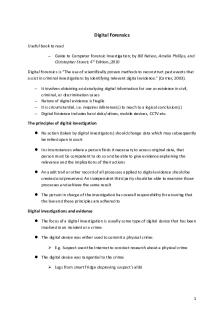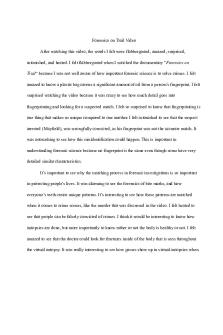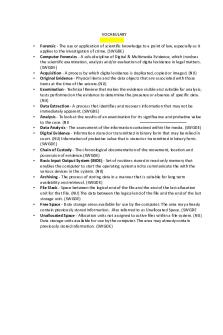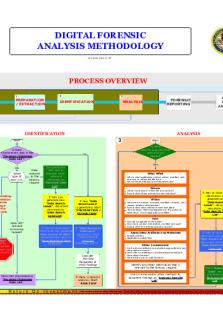Forensics Lab-02-Blood Spatter-Fall-21 PDF

| Title | Forensics Lab-02-Blood Spatter-Fall-21 |
|---|---|
| Author | Isabella Zagami |
| Course | General Chemistry I/Lab |
| Institution | Nova Southeastern University |
| Pages | 6 |
| File Size | 430.1 KB |
| File Type | |
| Total Downloads | 29 |
| Total Views | 152 |
Summary
forensic science, study of blood spatter on different stuff...
Description
Survey of Forensic Science Laboratory
Experiment 2: Blood Spatter Dr. Maria Ballester
Figure 1: Blood Spatter
Blood spatter can exhibit three types of velocity. The types of velocity are low, medium, and high. Low-velocity blood spatter is consistent with the dripping of blood. The blood may be dripping from a finger, nose, weapon, or other object. Generally speaking, low-velocity spatter appears circular. The shape may be affected by the surface on which it lands. If the low-velocity blood spatter lands on a smooth, hard surface, then the spatter will be in a circular shape (see Figure 2). If the lowvelocity blood spatter lands on a rough surface, more spatter occurs. Thus, the blood spatter may deviate from the circular shape.
Figure 2: Low-Velocity Blood Spatter on a smooth, semi-smooth, and rough surfaces
Medium-velocity blood spatter exhibits different characteristics than low-velocity spatter (Figure 3). However, there will be low-velocity blood spatter present in medium-velocity blood spatter. Medium-velocity blood spatter is consistent with being struck with a medium force. Some things that might create medium-velocity blood spatter would be getting struck with a baseball bat or a tire iron. The shape of the blood spatter changes with medium-velocity blood spatter. The blood spatter becomes more elongated. The third type of velocity is high. High-velocity blood spatter will contain characteristics of lowand medium-velocity spatter (Figure 3). High-velocity blood spatter is consistent with gunshot wounds and injuries from propellers. The force that is created on the blood causes it to become aerosolized. The blood spatter will resemble a fine mist.
Figure 3: Low, medium, and high velocity blood spatter patterns.
How does one determine which direction the blood spatter traveled? The direction of travel can be determined by the shape of the blood stain. The pointed end (tail) of the bloodstain always faces its direction of travel (Figures 4).
Figure 4: Blood Spatter traveled from Left to Right
The source of the blood spatter can be established by determining the point of convergence. The point of convergence is determined by drawing a line through the long axis of several blood stains. The method is two dimensional. The point in which the lines intersect is the convergence (Figure 5). The point of convergence is the source of the blood. After determining the point of convergence, the angle of impact is determined so the blood spatter can be “stringed.” The point of convergence and “stringing” are used to aid in the reconstruction of the crime scene. “Stringing” provides a three- dimensional perspective of the blood spatter (Figure 6).
2 M. Ballester-2021
Figure 5: Line drawn through long axis of blood stains, illustrating the point of convergence.
Figure 6: “Stringing” of blood spatter.
Prior to “stringing,” the angle of impact needs to be determined from several blood stains (Figure 7). The blood stains are labeled in chronological order starting with 1.
Figure 7: Labeled blood stains.
In addition to photographic documentation of the full blood spatter, close-up photographs are taken of the individual blood stains chosen for reconstruction. Once the appropriate blood stains are chosen, it is time to determine the angle of impact. The angle of impact is calculated by dividing the width by length (in millimeters) of the main body of blood stain. The tail is not used in determining the angle of impact. Use the listed equation to determine angle of impact.
3 M. Ballester-2021
After dividing the width by length, the answer will be a decimal (sine). Use the chart at the end of this chapter to find the decimal closest to the answer. The listed decimals will be under the column headed by Sine. The decimal will be associated with a degree. The degree is the angle of impact. The size of the blood stains may be affected if target surface is an absorbent or porous. Now that the degree of impact is determined, “stringing” can begin. A piece of string is taped near the main body of the blood stain on the long axis. Pull the string to the appropriate angle using an angle finder. The string will be pulled out along the long axis and at the angle of impact. The string will be pulled taut and anchored with tape. Each blood stain will be done accordingly. The “stringing” will provide the depth to the blood spatter.
4 M. Ballester-2021
Blood Spatter Angle of Impact Exercise Objective The student will determine the angle of impact of selected blood droplets.
Method 1. Using the worksheet and chart on the next page, determine the angle of impact for the droplets below.
5 M. Ballester-2021
Degrees 1 2 3 4 5 6 7 8 9 10 11 12 13 14 15 16 17 18 19 20 21 22 23 24 25
Sine 0.0175 0.0349 0.0523 0.0698 0 0872 0.1045 0.1219 0.1392 0.1564 0.1736 0.1908 0 2079 0.2250 0.2419 0.2588 0 2756 0 2924 0.3090 0.3256 0.3420 0.3584 0.3746 0.3907 0.4067 0.4226
Degrees 26 27 28 29 30 31 32 33 34 35 36 37 38 39 40 41 42 43 44 45 46 47 48 49 50
Sine 0.4384 0.454 0.4695 0.4848 0.5000 0.5150 0.5299 0.5446 0.5592 0.5736 0.5878 0 6018 0.6157 0 6293 0.6428 0.6561 0.6691 0.6820 0.6947 0.7071 0.7193 0.7314 0.7431 0.7547 0.7660
Degrees 51 52 53 54 55 56 57 58 59 60 61 62 63 64 65 66 67 68 69 70 71 72 73 74 75
Sine 0.7771 0.7880 0.7986 0 809 0.8192 0.8290 0.8387 0.8480 0.8572 0.8660 0.8746 0.8829 0.8910 0.8988 0 9063 0 9135 0 9205 0.9272 0 9336 0.9397 0.9445 0.9511 0 9563 0.9613 0.9659
Degrees 76 77 78 79 80 81 82 83 84 85 86 87 88 89
Sine 0.9703 0.9744 0.9781 0.9816 0.9848 0.9877 0.9903 0.9925 0 9945 0 9962 0.9976 0.9986 0.9994 0.9998
6 M. Ballester-2021...
Similar Free PDFs

- BN - Forensics
- 1 Pages

Forensics Crash Course
- 1 Pages

Forensics Chapter 1
- 5 Pages

Forensics Welcome Intrusion
- 1 Pages

Digital Forensics Reports
- 4 Pages

Digital Forensics Intro
- 9 Pages

Forensics on Trail Video
- 2 Pages

Chapter 1-11 forensics
- 39 Pages

Digital Forensics Vocabulary
- 1 Pages

forensics study notes
- 11 Pages

Answer Bank Cyber Forensics
- 73 Pages

Forensics Final Exam -5 essays
- 5 Pages
Popular Institutions
- Tinajero National High School - Annex
- Politeknik Caltex Riau
- Yokohama City University
- SGT University
- University of Al-Qadisiyah
- Divine Word College of Vigan
- Techniek College Rotterdam
- Universidade de Santiago
- Universiti Teknologi MARA Cawangan Johor Kampus Pasir Gudang
- Poltekkes Kemenkes Yogyakarta
- Baguio City National High School
- Colegio san marcos
- preparatoria uno
- Centro de Bachillerato Tecnológico Industrial y de Servicios No. 107
- Dalian Maritime University
- Quang Trung Secondary School
- Colegio Tecnológico en Informática
- Corporación Regional de Educación Superior
- Grupo CEDVA
- Dar Al Uloom University
- Centro de Estudios Preuniversitarios de la Universidad Nacional de Ingeniería
- 上智大学
- Aakash International School, Nuna Majara
- San Felipe Neri Catholic School
- Kang Chiao International School - New Taipei City
- Misamis Occidental National High School
- Institución Educativa Escuela Normal Juan Ladrilleros
- Kolehiyo ng Pantukan
- Batanes State College
- Instituto Continental
- Sekolah Menengah Kejuruan Kesehatan Kaltara (Tarakan)
- Colegio de La Inmaculada Concepcion - Cebu



